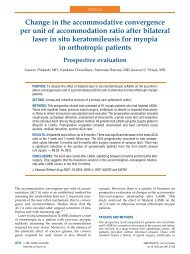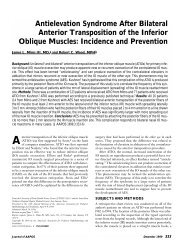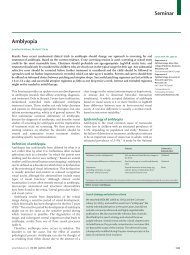What's new AAPOS 2008 - The Private Eye Clinic
What's new AAPOS 2008 - The Private Eye Clinic
What's new AAPOS 2008 - The Private Eye Clinic
Create successful ePaper yourself
Turn your PDF publications into a flip-book with our unique Google optimized e-Paper software.
GENETICS<br />
Marfan syndrome: from molecular pathogenesis to clinical treatment.<br />
Ramirez F, Dietz HC.<br />
Curr Opin Genet Dev. 2007 Jun; 17(3):252-8. Epub 2007 Apr 27.<br />
This is an excellent review article. He reviews that MFS is caused by mutations in<br />
fibrillin-1, the major constituent of extracellular microfibrils. Fibrillin-1 mutations perturb<br />
local TFGB signaling, in addition to impairing tissue integrity. Additionally Dietz reviews<br />
a <strong>new</strong> syndrome with overlapping Marfan syndrome-like manifestations that is caused<br />
by mutations in TGFB receptors 1 and II. Loeys-Dietz syndrome is an autosomal<br />
dominant disorder with both unique and marfan syndrome-like manifestations, such as<br />
aortic root aneurysm, aneurysms and dissections throughout the arterial tree, and<br />
generalized arterial tortuosity.<br />
He states that they TGFB signaling pathway is now considered an attractive target to<br />
counteract aneurysm progression in MFS, using traditional pharmacological means of<br />
therapy. TGFB involvement in MFS helps to conceptualize the origin of clinical<br />
variability by providing a number of candidate modifiers that are part of the TGFB<br />
signaling network. <strong>The</strong> genes encoding regulators and effectors of TGFB signaling<br />
have emerged as attractive candidates for the sites of mutations causing phenotypes<br />
that overlap with MFS or Loeys-Dietz syndrome. <strong>The</strong> definition of MFS has changed<br />
from a structural disorder of the connective tissue to a developmental abnormality with<br />
broad and complex effects on the morphogenesis and function of multiple organ<br />
systems.<br />
Marfan syndrome: <strong>Clinic</strong>al diagnosis and management.<br />
Dean JC.<br />
Eur J Hum Genet 2007 Jul; 15(7):724-33. Epub 2007 May 9.<br />
This is a superb review article, very practical. <strong>The</strong> clinical diagnosis of MFS is made<br />
using the Ghent nosolgy, which will unequivocally diagnose or exclude MFS in 86% of<br />
cases. <strong>The</strong> penetrance of the some features is age dependent, so the nosolgy must be<br />
used with caution in children. Molecular testing may be helpful in this context.<br />
He specifically addresses sports in the MFS patient: they should avoid high intensity<br />
static exercise, but can participate in lower intensity dynamic exercise. Contact sports<br />
are not advised to protect the aorta and the lens of the eye, and scuba diving should be<br />
avoided because of the increased risk of pneumothorax.<br />
<strong>The</strong> diagnosis of MFS requires a multidisciplinary team approach in view of its<br />
multisystem effects and phenotypic variability.<br />
55
















